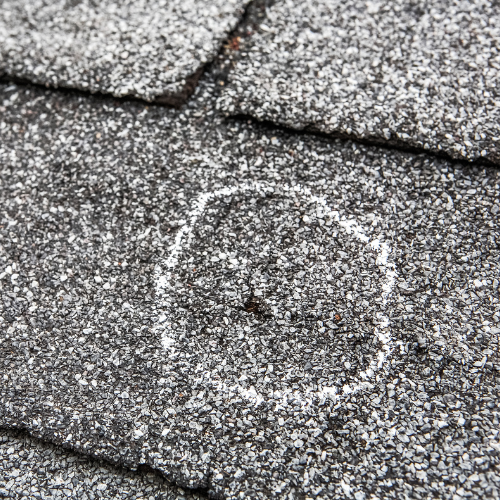If you were to ask any homeowner with one of the many common Texas roofing problems if they would’ve done anything differently, you’d undoubtedly hear this answer: “I would’ve done something sooner.”
Unfortunately, many homeowners tend to postpone roofing repairs until a significant problem arises, usually coinciding with nasty weather. Every time there’s a storm, a legion of homeowners in the same town call roofers at the same time for emergency repairs.
How do you avoid this scenario? Know when to call a roofing contractor ahead of time by learning about:
-
Typical causes of Texas roofing problems
-
Signs of roof damage
 COMMON CAUSES OF TEXAS ROOFING PROBLEMS
COMMON CAUSES OF TEXAS ROOFING PROBLEMS
For as resilient as roofs can be, they can still fall prey to numerous issues, particularly in parts of the country with unpredictable weather, hail storms, extreme heat, and pest problems–sound familiar?
Harsh Weather
In Texas, we get our fair share of violent storms and high winds. Particularly strong winds can dislodge parts of your roof that are already loose and worn with time. What’s more, winds can blow debris against your home and cause reaching branches from nearby trees to scratch and beat against your roof.
As if that weren’t enough, your roof also has hail to contend with. According to State Farm, Texas came in second in the nation for hail claims in 2022 with $510M in damages.
Heat Damage
Fluctuations in heat cause shingles to expand and contract. In places like Texas, where the temperature can change drastically from one day to the next, this puts shingles through a lot of stress. Additionally, extreme heat will accelerate your shingles’ aging process, making them more prone to crumbling.
Animal Damage
Unfortunately, there is no shortage of animals that can damage your roof.
-
Bats. Yes, you read that correctly. Although we appreciate bats for eating mosquitos, their urine and guano can build up on your roof and soak through into your attic ceiling and insulation.
-
Birds. While a few bird droppings here and there shouldn’t do much harm, the acidity of bird droppings in large quantities can damage your roof sheathing and shingles.
-
Squirrels. Sometimes these critters will try to make a home in your attic by chewing through your roof or dislodging shingles or tiles.
-
Termites. These pests can cause significant structural issues for roofs by eating away rafters, beams, framework, and roof decking (the material between the structural elements).
-
Rats. Like squirrels, rats will chew through shingles and tiles to get inside your home. Rats have also been well-known to build their nests inside roofs.
Age
The older your roof gets, the less durable it becomes. Even if your roof has never experienced any traumatic damage from falling debris, pests, or extreme weather conditions, eventually, every type of roof requires replacement.
Improper Installation
Cheaper isn’t always better. Sometimes when you go cheap on roof work, corners get cut to increase profits and save time. In other cases, that lower price point might also mean that you’re getting workers with less experience, which can lead to flaws in your roof installation.
Neglect
Because it’s so easy to forget about your home’s roof until something goes wrong, roofs often go without much-needed care and maintenance. These are some of the most common mistakes homeowners make:
-
Letting debris accumulate on top of the roof
-
Allowing moss and mold to grow on shady roof areas
-
Allowing trees to grow close enough to dislodge tiles or shingles
-
Neglecting to clean gutters, which can then cause water to back up into the attic
-
Postponing small repairs that then turn into extensive repairs
SIGNS OF A DAMAGED ROOF
Before the next big storm rolls in, make sure to get your roof inspected for these signs of damage.
Discoloration
Discoloration is a major clue that your roof has undergone sun damage. The sun has literally bleached your roof’s materials, and this is a fairly good indicator that the materials’ weatherproofing chemicals may not be up to par.
Warped Shingles
Check your roof for shingles that are curling up at the edges or not fitting into place the way they used to. It’s normal for a roof to develop warped shingles over time, but too many can decrease your roof’s ability to block out the elements.
Fractures or Indentations
Falling debris, such as tree branches or hailstones, cause this type of damage. Shingles with cracks or granule loss are weaker and, therefore, prone to even more damage from falling objects and strong winds when the next storm comes.
Signs of Water Damage
Your home’s interior can also lend you some insight as to how your roof is holding up. Check the ceiling as well as every nook and cranny of your attic for signs of leaks or water damage, such as staining, musty smells, or mold growth. If you see any of these red flags, get your roof inspected and repaired right away.
Bottom Line
A flawed roof can result in significant damage to your home and threaten the safety of those inside it. If you see any signs of damage, don’t wait to get an inspection from an experienced roofing contractor. After all, roof problems never get better on their own, and you don’t want to end up with a massive leak in the middle of the next major storm.
Dolan Roofing offers a complete selection of residential roofing services to combat all of the most common roofing problems San Antonio homeowners face. Contact us today to get started with an inspection and estimate.

 COMMON CAUSES OF TEXAS ROOFING PROBLEMS
COMMON CAUSES OF TEXAS ROOFING PROBLEMS


